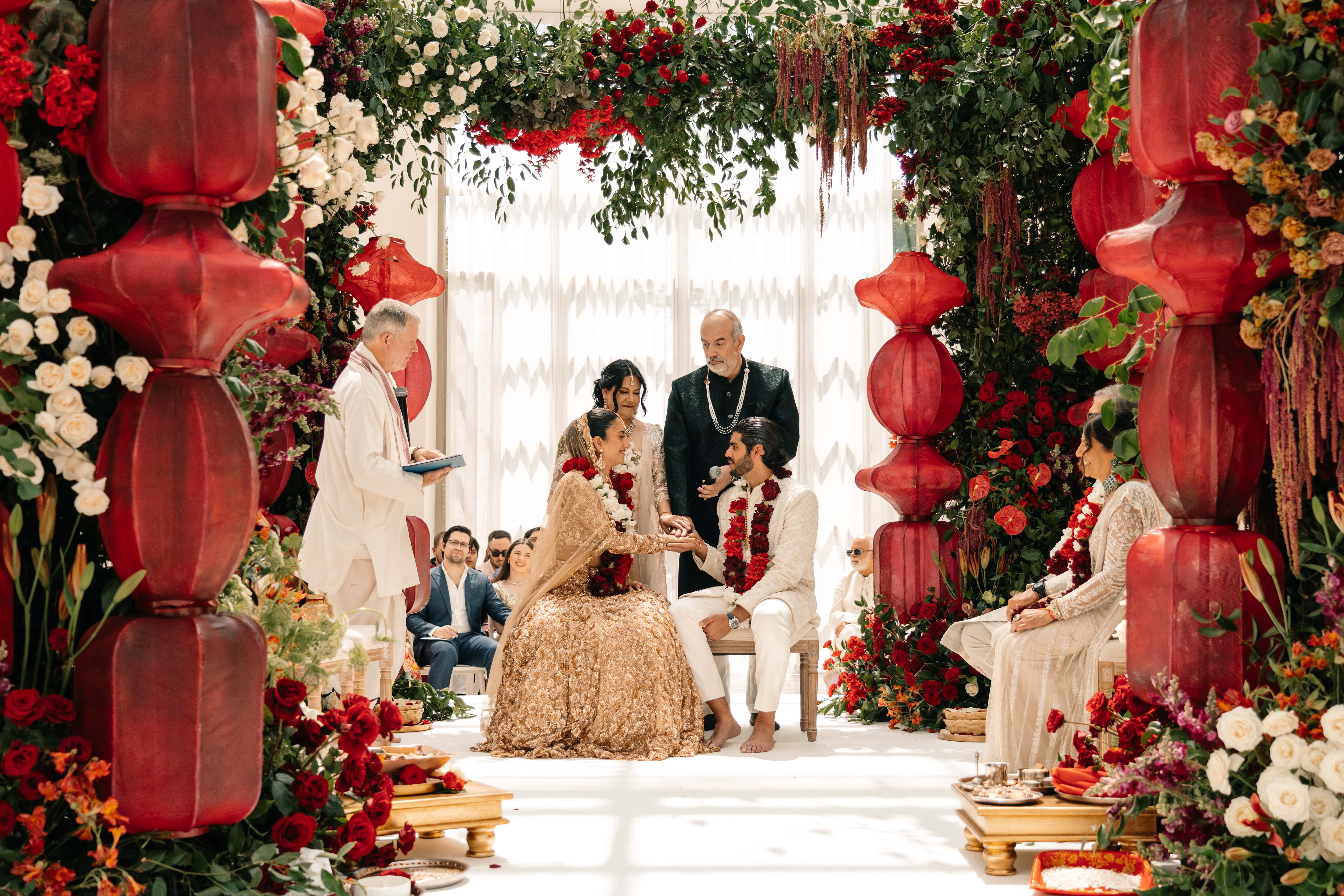The golden light of dawn bathed the cobblestone streets of San Miguel de Allende as Nabila & Neil’s guests prepared to accompany them through a full day, woven together by the rituals and symbols of a Hindu ceremony—moments that, altogether, would mark the most important day of their lives. Luna Escondida, one of Mexico’s top venues, where the verdant hills blend with monumental architecture and vibrant floral displays, was ready to celebrate the union of an international couple with South Asian roots in a deeply spiritual ceremony.
In Hindu weddings, every gesture, offering, and word spoken by the Pandit—the priest or spiritual guide—is imbued with meaning. Here, love is understood as a divine force: a union not only of two people but also of their families, lineages, and beliefs.
At the heart of the ceremony stands The Mandap, a sacred altar covered by a canopy and supported by four pillars representing the stages of life—Ashramas—and the four goals of human existence: Dharma (duty), Artha (prosperity), Kama (love), and Moksha (liberation). The mandap symbolizes the home, the space where the divine manifests. Within it, the sacred fire bears witness and blesses the bond uniting the couple.
A Hindu wedding is a tapestry of intricate rituals, each with a spiritual and emotional purpose. Yet, it can be understood through distinct stages that, when woven together, tell the story of love and the eternal promise between two souls.
The Ceremony, step by step
- Baraat – Groom’s Procession
The groom arrives accompanied by his family and friends, moving with music, dance, and celebration. The bride’s family greets them with garlands, marking the first meeting between two worlds.
- Milni – Families’ Introduction
The families exchange garlands as a symbol of union and respect, formalizing the bond between the two households that, from that moment on, become one.
- Dwarchar – Welcoming the Groom
The bride’s mother receives the groom with Aarti and sweets, blessing his arrival and wishing him prosperity.
- Procession to the Mandap
The Pandit invites the groom and all guests to move toward the mandap, where the main rituals will take place.
- Kanya Aagaman – Bride’s Entrance
The bride makes her grand entrance to the mandap, a moment of pure emotion: the arrival of the one who will be her partner in every step of life.
- Jai Mala – Exchange of Garlands
The bride and groom exchange flower garlands in a gesture of mutual acceptance and love. Tradition holds that whoever places the garland first will have the honor of leading and protecting the life they begin together.
- Sapradanam – Giving Away the Bride
The bride’s parents place her right hand in the groom’s, entrusting him with her care, protection, and happiness.
- Shila Rohan – The Rock Ceremony
The bride steps onto a stone, symbolizing the strength to overcome any challenges life may bring.
- Kusandika – Lighting the Sacred Fire
The Pandit lights the sacred fire at the center of the mandap. The couple offers ghee while Sanskrit mantras lift their prayers toward the heavens.
- Mangal Phera – The Seven Circles
The couple walks seven times around the fire, offering puffed rice with each circle. Each round represents a blessing: abundance, strength, love, wisdom, happiness, health, and eternal union.
- Sapta Padi Gamana – The Seven Steps
The couple takes seven steps together, sealing with each a vow that will guide their shared life.
- Mangala Sutra / Sindoor – The Sacred Necklace and Red Powder
The groom ties the mangala sutra, a sacred necklace—the equivalent of a wedding ring—around the bride’s neck and applies sindoor, a deep red powder traditionally made from turmeric and pigments, to the parting of her hair: visible symbols of their union and enduring commitment.
- Asir-vad – Final Blessings
The Pandit pronounces the final blessings, marking the beginning of a new life as a couple under the gaze of the gods and the joy of those present.
A celebration guided by depth and respect
Accompanying Nabila and Neil not only during their wedding weekend but also throughout the planning of each event and ritual was an experience guided by sensitivity and respect for their traditions. Every detail was carefully attended to, reflecting the spiritual depth of their culture and the meaning inherent in each gesture. In the end, the celebration became a composition of colors, symbols, and offerings that honored not only their union but also the spiritual richness that inspired it.


